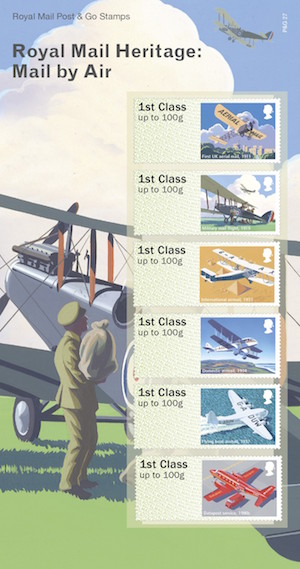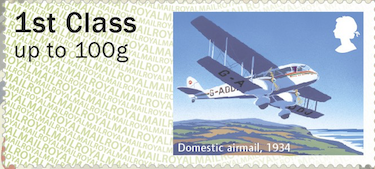Norvic Philatelics - GB New Stamps and Special Postmarks
Pictorial Faststamps: Mail by Air - 13 September 2017
Pictorial Post & Go stamps appear in
machines in UK Post Offices for defined periods of time in the year and
this series is intended to provide attractive stamps that are appropriate
for the season in which they are issued.
Post & Go stamps are sold from Post
Office Self-Service Kiosks (SSK), which allow customers to weigh their
letters and packets, pay for and print postage stamps and stationery
supplies, often without the need to visit the counter. The first Post
& Go machine was trialled in The Galleries Post Office® in Bristol in
2008. The labels will be used in Post & Go machines at Post
Offices around the country, and from Royal Mail machines at Enquiry
Offices, Museums and Autumn Stampex. The labels can be obtained with
6 different service indicators: 1st class up to 100g & 1st class Large
up to 100g, a dual-value Europe up to 20g/World up to 10g, Europe 100g,
Worldwide 20g, and Worldwide 100g. From SSKs other stamps can be
printed with monetary values for a variety of services including Special
Delivery and parcels.
From top left: First UK aerial mail and
Windsor Castle 1911, Military Mail flight 1919, International
airmail 1933,
Domestic airmail 1934, Flying boat airmail 1937, Database
service 1980s.
|
|
In Feb 2016 Royal Mail issued the Royal Mail Heritage:
Transport set as part of the Royal Mail 500 celebrations. Post
& Go issues in 2017 will build on the theme, creating a series of
issues in which the transportation of mail is explored in greater
detail. The second in the series is Mail by Air.
Mail transportation by aeroplane was inaugurated in February 1911, when the
world’s first airmail was carried at an exhibition in Allahabad, India.
Seven months later, the UK’s first aerial post was flown from Hendon to
Windsor in honour of King George V’s coronation – between 9 and 26
September, 20 flights were made between the two locations, which constituted
the world’s first regular airmail service.
In 1919, the RAF introduced flights between Folkestone and Cologne to carry
mail to British forces. Later that year, the first public
international air service was initiated, transporting civilian mail between
London and Paris.
After its founding in 1924, Imperial Airways established numerous airmail
routes across Europe to the Empire in India and Africa. In December 1934,
following experimental flights three years earlier, a full direct mail
service to Australia was inaugurated.
Carrying mail by air soon became a regular feature across the UK – in May
1934, Britain’s first scheduled domestic airmail service was launched when
Highland Airways began operating a regular daily service from Inverness to
the Orkney Isles.
The stamps in detail
First UK aerial mail, 1911
At 4.58pm, on 9 September 1911, Gustav Hamel flew from Hendon to
Windsor in a Blériot monoplane carrying 23½lb of mail, which included
letters to King George V and other dignitaries. The stamp depicts Hamel
flying over Windsor Castle prior to landing at Shaw Farm meadow, Frogmore,
at 5.13pm.
Military mail flight, 1919
In 1919, the RAF began operating a mail-carrying service between
Folkestone and Cologne. Following a rail and road journey from London to the
aerodrome, mail was loaded onto a De Havilland DH.10 and flown to troops in
Germany. Between 1 March and 31 August 1919, 922 flights were made.
International airmail, 1933
Imperial Airways’ Handley Page HP.42E airliners first entered into
service in 1931. G-AAXF Helena is depicted flying over the pyramids in
Egypt, on the Cairo-Gaza-Karachi sector, in 1933. During their eight years
of service, the HP.42s carried an exceptional amount of mail. The Empire Air
Mail Scheme was introduced in 1937 to carry first-class mail for 1½d by air
within the British Empire.
Domestic airmail, 1934
The most versatile of aircraft was the De Havilland DH.84 Dragon
II, which was used by the majority of airlines for mail and passenger
duties. Railway Air Services Ltd had a total of 11 DH.84s in its fleet, of
which G-ADDJ City of Plymouth is depicted in flight in 1934.
Flying boat airmail, 1937
The Empire Air Mail Scheme was introduced in 1937 to carry
first-class mail for 1½d by air within the British Empire. Imperial Airways
used flying boats to operate the new service and commissioned Shorts of
Rochester to produce 28 of the C class for this purpose. G-ADUW Castor is
depicted on take-off.
Datapost service, 1980s
Datapost was introduced as an express mail service for guaranteed
next-day delivery in any part of the UK, transporting mail bags from
airports all over the country. The aeroplane depicted is an Embraer
Bandeirante EMB.110P1 G-POST operated by the Scottish company Air Ecosse.
Technical details:
Designed by Osborne Ross with illustrations by Andrew Davidson.
‘International airmail, 1932’ – illustration based on a photograph of
Handley Page HP42E (G-AAXF) of Imperial Airways by Charles E Brown ©
Trustees of the Royal Air Force Museum; ‘Flying boat airmail, 1937’ –
illustration based on a photograph of Castor ‘Short Empire Flying Boat’ ©
Short Brothers (Rochester & Bedford) Ltd, used with kind permission of
Bombardier
Printed in gravure by International Security Printers, 56 x 25 mm, with two
phosphor bands, self-adhesive.
These will be on sale from machines Autumn Stampex. For
more information see our blog.
Products issued
The labels will be used in Post & Go machines at Post Offices and
Royal Mail Enquiry Offices around the country, and from the Royal Mail
machines at Autumn Stampex.
A mint set of 6 x 1st will also be available from Royal Mail's Tallents
House Bureau in a pack similar to a presentation pack. All values in
the pack are 1st Class and the details are printed in gravure.
Royal Mail will again produce a First Day Cover and official First Day
Postmarks for these stamps.
Special postmarks available for the day of issue
were shown in Royal Mail's Postmark Bulletins (download
here)
This page created 25 August 2017
If you wish to be told when this page is updated, please use the
ChangeDetection box at the top of this page.
If you have any questions, please email
us.
NB: all emails will be acknowledged in 1-2 days
unless we are away (see home page). If you do not receive an
acknowledgement please email us from a different address (eg hotmail,
gmail).













